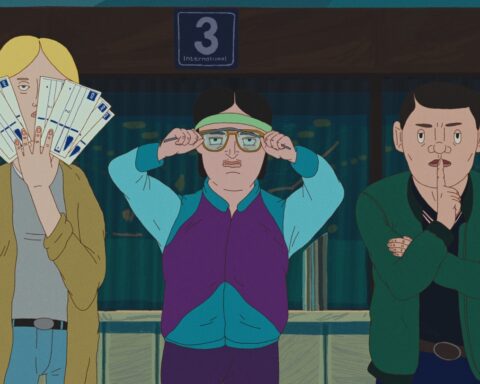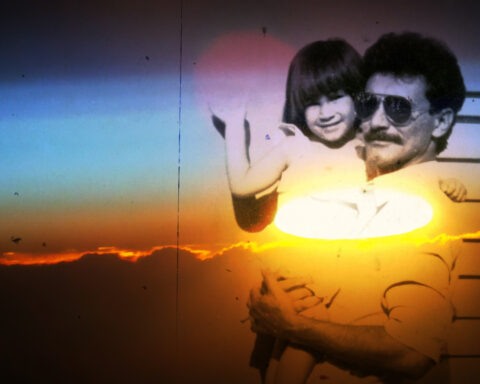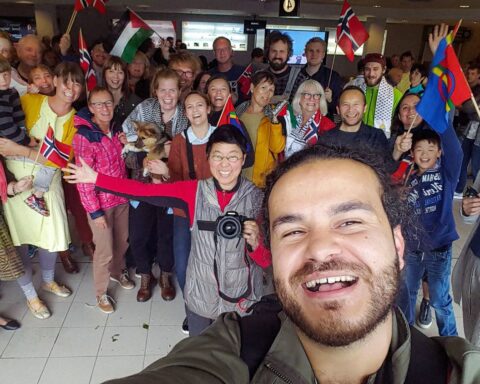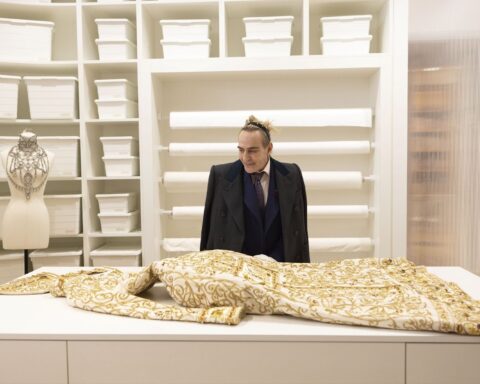Amidst the various concerns that inform the films of Turkish-born, US-based artist and filmmaker Nazli Dinçel is a recurring curiosity in touch. Her films are often populated by bodies seen most often in fragments, both lonely and in embrace, explicit yet never pornographic. With a poetic form that manages to hold lightness and intensity at the same time, Dinçel’s films record the body in context with arousal, emigration, disturbance and desire, all through a fascination and focus on the medium’s material. Working exclusively on 16mm film, Dinçel continuously disrupts, challenges and manipulates sound, text and image. She is in a constant conversation with the filmic material that is both intimate and defiant, both vulnerable and rough but always intermingling in unexpected ways.
On February 13th, non-fiction screening series Vertical Features screened a collection of Dinçel’s 16mm films, including the Toronto Premiere of several recent works. Just before the screening, we sat down and had a conversation about Dinçel’s work, intentions and experiences.
Dinçel said that a lot of people, because of writings around her work, presume that her films are rather intense and heavy while she feels they are not like that at all. Her work is created with the intention of being accessible and relatable, through an intermingling of the intense and the light.
Dinçel made this discovery years ago while studying at an experimental film school in Milwaukee after emigrating from Turkey at the age of 17. As she consumed work, she would always ask herself “What do I remember? Why did this piece stand out from the rest?” Dinçel found that the pieces that stuck with her were those that made her uncomfortable, either because they were really dense and intense or very light and humorous, or both. “I guess that’s what I’m trying to achieve…holding lightness and intensity at the same time,” Dincel tells POV. “It makes it more relatable, I think.”
Instructions on How to Make a Film (excerpt) from Nazlı Dinçel on Vimeo.
Text and layering are a big part of Dinçel’s work, and in her most recent films there are more academic texts etched into her films. Dinçel told me that viewers sometimes tend to take things too literally: they strive to understand and decipher every word, layer or message, which she believes could become frustrating and is far from her intention. To her, “it’s meant to allow someone to let go and have an experience of what they’re seeing instead of trying to understand every word and every context. It’s not about making my viewers feel uncomfortable or stupid it’s the exact opposite. It’s meant to give the viewer freedom to wander, not to restrict the experience.”
While growing up in Turkey, the freedom to wander and experience was only accessible to Dinçel through books and films. Dinçel told me that “the environment was so oppressive for a young woman that I would just find escape in watching movies… consuming other films or reading extensively was just a way of escaping that situation.” And it was that escape into the worlds of other films that started her fascination with film, which was further fueled and honed by the experimental program in Milwaukee where she fell in love with analog filmmaking.
Dinçel’s work always pushes the limits of the material itself as she reflects on experiences of disturbance—her material vulnerable yet tough, ragged yet smooth. Juicy pomegranates, patchy glittery nail polish, hand caressing floral fabric, crushed flowers, aroused sexual organs intermingle with Dinçel’s formal interventions and a diaristic retelling of rude sexual awakenings in Solitary Acts (4,5,6). In Solitary Act 4, Dinçel presents her body in close-up as filmic material – a nearness at once disembodied and nameless, yet also daringly public. The hand-processed 16mm film flickers over footage of female masturbation: images of fingers as they rub the clitoris and vulva are intercut by typed text etched into the emulsion. We hear Dinçel recount stories of her first sexual experiences using vegetables and showerheads and learn about the suppression of her sexuality by family figures that sought to contain or rather claim her body and habits.
Considering the nature of Dinçel’s film, I wondered if she had ever shown her work in Turkey, and if so, how it was received. She told me it hasn’t happened often, and she understands why, but believes that “the people there need to be exposed to this sort of work the most.” She goes on: “They will identify with it better…Maybe seeing my work will give them more courage to be more of an opposition…but it can be dangerous.” The last time she showed her work in Turkey was in a microcinema named FLO just after the coup attempt in 2016. Dinçel told me, “I was having nightmares about someone coming in to shoot me in my Q&A or some ridiculous stuff you know?” Fortunately, her fears were not confirmed.
When she’s not making films and screening her work, Dinçel lives with her partner Kevin Reiss in an apartment above a sausage hut which they themselves are reconstructing into a non-profit film lab. They hope for it to become a year-round residency where they would invite artists and filmmakers to use their equipment and space to create work. Dinçel said, “We’re just trying to create this idealistic space you know? And it’s intense. ” The word intense is always present when one encounters Dinçel’s work and her presence – but with that very same intensity lies a lightness and gentility. That same coexistence was in our very conversation itself, with Dinçel carrying a presence that is at once powerful and light. At one point, I proposed to Dinçel that she tell me something she’d want to tell herself and others, perhaps a reminder and affirmation of some sorts. Dinçel said, “I guess the answer would be: don’t take yourself so seriously. It’s the key to existing, right?”
Solitary Acts #4 (excerpt) from Nazlı Dinçel on Vimeo.









